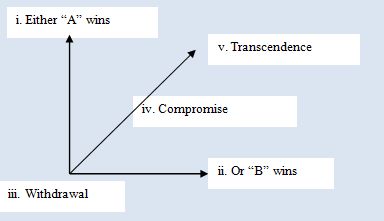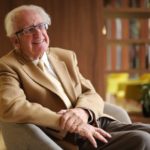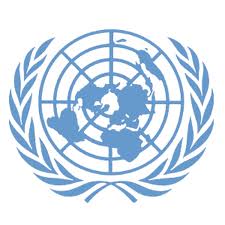The TRANSCEND Method: Conflict Transformation by Peaceful Means
FEATURED RESEARCH PAPER, 27 Nov 2017
Johan Galtung | Governance and Social Development Resource Centre – TRANSCEND Media Service
United Nations Disaster Management Training Programme
The TRANSCEND Method is based on the central thesis that to prevent violence and develop the creative potential of a conflict, there has to be transformation. At the root of the method is the understanding of conflict as incompatible goals, meaning as a problem to be solved; not as incompatible parties (persons, countries etc.), meaning as one or more parties to be controlled (usually not oneself).This training manual from the United Nations Disaster Management Training Programme (DMTP) gives an overview of the approach and explains how to put it into practice. Transforming a conflict requires transcending the goals of conflicting parties, defining other goals, disembedding the conflict from its original situation and embedding it in a more promising place. This is achieved through dialogue based on empathy, non-violence and joint creativity. Failure to transform conflicts leads to violence.
A conflict has its own life cycle. Normal conflicts are complex and involve many actors, goals and issues. Incompatible goals can breed contradictions, which – combined with attitudes of hatred and violent behaviour – generate conflict. Violent cultures (which legitimise violence), violent structures (which exploit and alienate) and violent actors can combine to produce basic conflicts, which, if unattended, can spiral into meta-conflicts. The task is to transform conflicts, through a focus on cultures, structures and actors, by finding positive goals for all parties and imaginative ways of combining them.
The TRANSCEND Method has six basic premises, drawn from Hindu, Buddhist, Christian, Daoist, Islamic and Judaic thought respectively. These include: consideration of conflict as a source of both violence and development; mutual causation and shared responsibility; and the importance of dialogue. Ultimately the TRANSCEND Method aims to help bring parties together in a self-sustaining process.
- Transcendence means redefining the situation so that what looked incompatible is unlocked, opening up a new landscape. Creativity, and its application to contradictions, is the key.
- It is important to map out the conflict formation and to include all parties, goals and issues, remembering to bring in forgotten stakeholders.
- Initial dialogue is undertaken with each party individually to identify valid goals, eliciting creative approaches from all parties to find ways of transcending incompatibilities.
- Specific goals should be identified that are acceptable to each party individually in order to arrive at overarching goals that are acceptable to all parties collectively.
The primary tool is empathetic, respectful dialogue that explores the conflict. Important considerations are included in the code for conflict or peace workers applying the TRANSCEND Method:
- Identify positive elements in the parties and the conflict itself to create the potential for further development. Emphasise shared roots and responsibilities, rather than distributing blame and guilt.
- Be creative and suggest alternative courses of action. Collectively find a short, memorable outcome formula, for example ‘sustainable development’, that may not do justice to all complexities, but may facilitate communication.
- Do not demand consensus, commitment or co-operation from parties who are not ready. Equally do not ‘deform’ the conflict by pushing agendas too far away from the parties’ immediate concerns.
- Do not manipulate. Be open and honest with yourself and others about aims and feelings, remembering that the conflict worker’s task is to empower.
- Do not judge. Retain confidentiality and do not seek publicity or gratitude.
- Remember that conflict work is the art of the impossible, requiring optimism, idealism of the heart and realism of the brain.

Source:
Galtung, J., 2000, Conflict Transformation by Peaceful Means (The TRANSCEND Method)-Participants’ and Trainers’ Manual, United Nations Disaster Management Training Programme, Geneva
Download Full Text in pdf (1.58 MB):
TRANSCEND Method & Manual UN
_______________________________________________
 Johan Galtung, a professor of peace studies, dr hc mult, is founder of TRANSCEND International and rector of TRANSCEND Peace University. Prof. Galtung has published more than 1500 articles and book chapters, 500 Editorials for TRANSCEND Media Service, and more than 170 books on peace and related issues, of which more than 40 have been translated to other languages, including 50 Years – 100 Peace and Conflict Perspectives published by TRANSCEND University Press. More information about Prof. Galtung and all of his publications can be found at transcend.org/galtung.
Johan Galtung, a professor of peace studies, dr hc mult, is founder of TRANSCEND International and rector of TRANSCEND Peace University. Prof. Galtung has published more than 1500 articles and book chapters, 500 Editorials for TRANSCEND Media Service, and more than 170 books on peace and related issues, of which more than 40 have been translated to other languages, including 50 Years – 100 Peace and Conflict Perspectives published by TRANSCEND University Press. More information about Prof. Galtung and all of his publications can be found at transcend.org/galtung.
The Governance and Social Development Resource Centre provides applied knowledge services on demand and online. Our expertise is in issues of governance, social development, humanitarian response and conflict. Our specialist research team supports a range of international development agencies, synthesising the latest evidence and expert thinking to inform policy and practice. GSDRC is a partnership of research institutes, think-tanks and consultancy organisations. The GSDRC team has been providing high quality knowledge services to international development agencies including DFID, the Australian Government, the European Union, the OECD, the World Bank, and UNDP.
DISCLAIMER: The statements, views and opinions expressed in pieces republished here are solely those of the authors and do not necessarily represent those of TMS. In accordance with title 17 U.S.C. section 107, this material is distributed without profit to those who have expressed a prior interest in receiving the included information for research and educational purposes. TMS has no affiliation whatsoever with the originator of this article nor is TMS endorsed or sponsored by the originator. “GO TO ORIGINAL” links are provided as a convenience to our readers and allow for verification of authenticity. However, as originating pages are often updated by their originating host sites, the versions posted may not match the versions our readers view when clicking the “GO TO ORIGINAL” links. This site contains copyrighted material the use of which has not always been specifically authorized by the copyright owner. We are making such material available in our efforts to advance understanding of environmental, political, human rights, economic, democracy, scientific, and social justice issues, etc. We believe this constitutes a ‘fair use’ of any such copyrighted material as provided for in section 107 of the US Copyright Law. In accordance with Title 17 U.S.C. Section 107, the material on this site is distributed without profit to those who have expressed a prior interest in receiving the included information for research and educational purposes. For more information go to: http://www.law.cornell.edu/uscode/17/107.shtml. If you wish to use copyrighted material from this site for purposes of your own that go beyond ‘fair use’, you must obtain permission from the copyright owner.
2 Responses to “The TRANSCEND Method: Conflict Transformation by Peaceful Means”
Read more
Click here to go to the current weekly digest or pick another article:
FEATURED RESEARCH PAPER:

In my experience in the Middle East, specifically with Israelis & Palestinians;
1. Necessary to respect, not necessarily scerpt, competing narratives;
2. Seeking collaboration on issues within specific sectors (e.g. water & sanitation, waste management) will lead to understanding understanding & goodwill;
3. Differentiate between Track I (politicians) andcTrack II (profession & NGO leaders). Track II collaboration between conflicted parties on specific sectoral issues is easier as there tends to be mutual respect. Track I politicians can be persuaded by Track II collaboration successes.
4. Dialogue without specific collaborative goals within specific sectors has not resulted in significant reduction in societal conflict.
Recommendation: add to the Transcend Method a Track II sectoral collaboration project designed to achieve positive outcomes for the conflict parties.
The Arava Institute for Environmental Studies at Kibbutz Ketura is on successful institution using a sectoral approach to conflict reduction.
Rotary International is one of the largest NGOs promoting understanding, goodwill & peace and will be establishing a Rotary Middle East Peace Center and the Arava Institute is a candidate to implement this initiative.
Dear Mark–Thanks, and by and large in total agreement.
But, I do not use Track I-Track II language. My experience is that if NGOs like TRANSCEND come up with acceptable and sustainable visions, states tend to follow. Who is I and who is II is less obvious if NGOs have more idea power, even if states have economic-military-political power.
Rotary has been a very important forum for us in TRANSCEND all over the world. When it comes to Rotary as a peace actor I have seen less. I have a number of Rotary meetings coming up now, will ask them.
Best regards for 2018.
Johan Galtung Dr hc mult
Profesor of peace studies
Founder, TRANSCEND